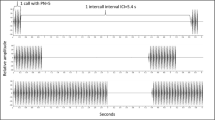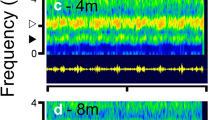Abstract
Previous studies have shown that sexually signaling males across different taxa show stereotyped spacing behavior that may be related to aspects of their signals, such as intensity. However, few studies have shown that the separation between signaling males affects their relative attractiveness. Using two sound traps broadcasting the calling song of the cricketEunemobius carolinus, we show that the separation, relative intensity, and absolute intensity of the calling songs influence calling song attractiveness. For calling songs separated by 5 m, the proportion of individuals attracted to the higher intensity song increased as the relative intensity difference of the two songs increased from 3 to 6 dB. For calling songs that differed by 6 dB, relative attraction to the less intense song decreased with decreasing song separation. These two results are consistent with the predictions of a model (Forrest and Raspet, 1994) that suggests that dense spacing is more costly for less powerful singers and that this cost increases with increasing differences in relative intensity. When the relative intensity of the songs was held constant (6 dB), we found that discrimination between songs decreases as the song absolute intensity increases. In particular, a greater proportion of individuals was attracted to the high-intensity song when the songs were broadcast at 103 and 97 dB than when the songs were broadcast at 109 and 103 dB. Unlike mammals and birds, the ability ofE. carolinus to discriminate between songs that differ in intensity may decrease as the absolute intensity increases. This may mean that females are less discriminating when they are closer to singing males.
Similar content being viewed by others
References
Alexander, R. D. (1975). Natural selection and specialized chorusing behavior in acoustic insects. In Pimentel, D. (ed.),Insects, Science and Society, Academic Press, New York, pp. 35–77.
Arak, A., and Eiriksson, T. (1992). Choice of singing sites by male bushcrickets (Tettigonia viridissima) in relation to signal propagation.Behav. Ecol. Sociobiol. 30: 365–372.
Arak, A., Eiriksson, T., and Radesater, T. (1990). The adaptive significance of acoustic spacing in male bushcricketsTettigonia viridissima: A perturbation experiment.Behav. Ecol. Sociobiol. 26: 1–7.
Bailey, W. J. (1985). Acoustic cues for female choice in bushcrickets (Tettigoniidae). In Kalmring, K., and Elsner, N. (eds.),Acoustic and Vibrational Communication in Insects, Verlag Paul Parey, Berlin, pp. 101–110.
Bailey, W. J., and Thiele, D. R. (1983). Male spacing behaviour in the Tettigoniidae: An experimental approach. In Gwynne, D. T., and Morris, G. K. (eds.),Orthopteran Mating Systems, Westview Press, Boulder, CO, pp. 163–184.
Bidochka, M. J., and Snedden, W. A. (1985). Effect of nuptial feeding on the mating behaviour of female ground crickets.Can. J. Zool. 63: 207–208.
Brown, W. D., Wideman, J., Andrade, M. C. B., Mason, A. C., and Gwynne, D. T. (1996). Female choice for an indicator of male size in the song of the black-horned tree cricket,Oecanthus nigricornis (Orthoptera: Gryllidae: Oecanthinae).Evolution 50: 2400–2411.
Cade, W. (1979). Alternative male strategies: Genetic differences in crickets.Science 212: 563–564.
Cade, W. (1981). Field cricket spacing, and the phonotaxis of crickets and parasitoid flies to clumped and isolated cricket calling songs.Z. Tierpsychol. 55: 365–375.
Cade, W., and Cade, E. S. (1992). Male mating success, calling and searching behaviour at high and low densities in the field cricket,Gryllus integer.Anim. Behav. 43: 49–56.
Doolan, J. M. (1981). Male spacing and the influence of female courtship behaviour in the bladder cicada,Cystosoma saundersii Westwood.Behav. Ecol. Sociobiol. 9: 269–276.
Fay, R. R. (1988).Hearing in Vertebrates: A Psychophysics Databook, Hill-Fay Associates, Winnetka, IL.
Forrest, T. G. (1983). Calling song and mate choice in mole crickets. In Gwynne, D. T., and Morris, G. K. (eds.),Orthopteran Mating Systems, Westview Press, Boulder, CO, pp. 185–204.
Forrest, T. G. (1991). Power output and efficiency of sound production by crickets.Behav. Ecol. 4: 327–338.
Forrest, T. G. (1994). From sender to receiver: Propagation and environmental effects on acoustic signals.Am. Zool. 34: 644–654.
Forrest, T. G., and Green, D. (1991). Sexual selection and female choice in mole crickets (Scapteriscus: Gryllotalpidae): Modeling the effects of intensity and male spacing.Bioacoustics 3: 93–109.
Forrest, T. G., and Raspet, R. (1994). Models of female choice in acoustic communication.Behav. Ecol. 5: 293–303.
Forrest, T. G., Sylvester, T. L., Jr., Testa, S., III, Smith, S. M., Dinep, A., Cupit, T. L., Huggins, J. M., Atkins, K. L., and Eubanks, M. (1991). Mate choice in ground crickets (Gryllidae: Nemobiinae).Fla. Entomol. 74: 74–80.
Gerhardt, Y. C. (1987). Evolutionary and neurobiological implication of selective phonotaxis in the green treefrog,Hyla cinerea. Anim. Behav.35: 1479–1489.
Green, D. M. (1976).An Introduction to Hearing, Wiley & Sons, New York.
Greenfield, M. D., and Shelly, T. E. (1985). Alternative mating strategies in a desert grasshopper: Evidence of density-dependence.Anim. Behav. 33: 1192–1210.
Gwynne, D. T. (1982). Male selection by female katydids (Orthoptera, Tettigoniidae:Conocephalus nigropleurum).Anim. Behav. 30: 734–738.
Gwynne, D. T. (1984). Courtship feeding increases female reproductive success in bushcrickets.Nature 307: 362–363.
Latimer, W., and Schatral, A. (1986). Information cues used in male competition byTettigonia cantans (Orthoptera: Tettigoniidae).Anim. Behav. 34: 162–168.
Mays, D. L. (1971). Mating behavior of nemobiine crickets:Hygronemobius, Nemobius andPteronemobius (Orthoptera: Gryllidae).Fla. Entomol. 54: 113–126.
Moiseff, A., Pollack, G. S., and Hoy, R. R. (1978). Steering responses of flying crickets to sound and ultrasound: Mate attraction and predator avoidance.Proc. Natl. Acad. Sci. USA 75: 4052–4056.
Morris, G. K., Kerr, G. E., and Fullard, J. H. (1978). Phonotactic preferences of female meadow katydids (Orthoptera: Tettigoniidae:Conocephalus nigropleurum).Can. J. Zool. 56: 1479–1487.
Pollack, G. S., and Plourde, N. (1982). Directionality of acoustic orientation in flying crickets.J. Comp. Physiol. 146: 207–215.
Robertson, J. G. M. (1984). Acoustic spacing by breeding males ofUperoleia rugosa (Anura: Leptodactylidae).Z. Tierpsychol. 64: 283–297.
Römer, H., and Bailey, W. J. (1986). Insect hearing in the field. II. Male spacing behaviour and correlated acoustic cues in the bushcricketMygalopsis marki.J. Comp. Physiol. 159: 627–638.
Schatral, A., and Latimer, W. (1988). A field study on the acoustic behavior of mobile singers in the bush cricketPsorodonotus illyricus, J. Nat. Hist. 22: 297–312.
Schatral, A., Latimer, W., and Broughton, B. (1984). Spatial dispersion and agonistic contacts of male bush crickets in the biotope.Z. Tierpsychol. 65: 201–214.
Schatral, A., Latimer, W., and Kalmring, K. (1985). The role of the song for spatial dispersion and agonistic contacts in male bushcrickets. In Kalmring, K., and Elsner, N. (eds.),Acoustic and Vibrational Communication in Insects, Verlag Paul Parey, Berlin, pp. 111–116.
Schmitz, B. (1985). Phonotaxis inGryllus campestris L. (Orthoptera, Gryllidae) III. Intensity dependence of the behavioural performance and relative importance of tympana and spiracles in directional hearing,J. Comp. Physiol. A 156: 165–180.
Shelly, T. E., Greenfield, M. D., and Downum, K. R. (1987). Variation in host plant quality: Influences on the mating system of desert grasshopper.Anim. Behav. 35: 1200–1209.
Simmons, L. W. (1988). Male size, mating potential and lifetime reproductive success in the field cricket.Gryllus bimaculatus (De Geer).Anim. Behav. 36: 372–379.
Stout, J. F., and McGhee, R. (1988). Attractiveness of the maleAcheta domesticus calling song to females II. The relative importance of syllable period, intensity, and chirp rate.J. Comp. Physiol. A 164: 277–287.
Thornhill, R., and Alcock, J. (1983).The Evolution of Insect Mating Systems, Harvard University Press, Cambridge, MA.
Ulagaraj, S. M., and Walker, T. J. (1973). Phonotaxis of crickets in flight: Attraction of male and female crickets to male calling songs.Science 182: 1278–1279.
Wagner, W. E. (1996). Convergent song preferences between female field crickets and acoustically orienting parasitoid flies.Behav. Ecol. 7: 279–285.
Walker, T. J. (1982). Sound traps for sampling mole cricket flights (Orthoptera: Gryllotalpidae:Scapteriscus).Fla. Entomol. 65: 105–110.
Walker, T. J. (1983). Mating modes and female choice in short-tailed crickets (Anurogryllus arboreus) In Gwynne, D. T., and Morris, G. K. (eds.),Orthopteran Mating Systems, Westview Press, Boulder, CO, pp. 240–267.
Walker, T. J., and Forrest, T. G. (1989). Mole cricket phonotaxis: Effects of intensity of synthetic calling song (Orthoptera: Gryllotalpidae:Scapteriscus acletus).Fla. Entomol. 72: 655–659.
Wilczynski, W., and Brenowitz, E. A. (1988). Acoustic cues mediate inter-male spacing in a neotropical frog.Anim. Behav. 36: 1054–1063.
Zar, J. H. (1984).Biostatistical Analysis, Prentice-Hall, Englewood Cliffs, NJ.
Author information
Authors and Affiliations
Rights and permissions
About this article
Cite this article
Farris, H.E., Forrest, T.G. & Hoy, R.R. The effects of calling song spacing and intensity on the attraction of flying crickets (orthoptera: Goryllidae: Nemobiinae). J Insect Behav 10, 639–653 (1997). https://doi.org/10.1007/BF02765384
Revised:
Issue Date:
DOI: https://doi.org/10.1007/BF02765384




